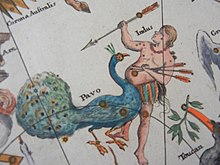Southern Birds in the sky -Peacock,Phoenix & others
The constellations Grus, Pavo, Phoenix and Tucana are collectively known as the "Southern Birds".
Grus is a constellation in the southern sky. Its name is Latin for the crane, a type of bird.
Grus is bordered by Piscis Austrinus to the north, Sculptor to the northeast, Phoenix to the east, Tucana to the south, Indus to the southwest, and Microscopium to the west.
There are no myths associated with the constellation.
Grus was one of the 12 constellations created by Dutch explorers in the late 16th century.
The only connection the crane has with mythology lies in the fact that it was a sacred bird to the god Hermes.
Pavo is a constellation in the southern sky whose name is Latin for
"peacock"
"In Greek myth the stars that are now the Peacock ,
were Argos [or Argus], builder of the ship Argo.
He was changed by the goddess Juno into a peacock and placed in the sky along with his ship.
"Indeed, the peacock "symboliz[ed] the starry firmament" for the Greeks,and the goddess Hera was believed to drive through the heavens in a chariot drawn by peacocks.
In another story the peacock was the sacred bird of Hera, who drove through the air in a chariot drawn by peacocks.
Zeus turned his illicit love Io,a beautiful princess of Argos,into a white cow to disguise her from his wife, Hera, who nearly caught them together.
Hera was suspicious and put the heifer under the guardianship of Argus, who tethered the animal to an olive tree.
Argus was ideally suited to the task of watchman, since he had 100 eyes, of which only two were resting at a time while the others kept a look out.
Wherever Argus stood, he could always keep several of his eyes on Io.
Zeus sent his son Hermes to release Io from her captivity.
Hermes swooped down to Earth and spent the day with Argus, telling him stories and playing his reed pipes until, one by one, the eyes of Argus became sleepy and began to close.
When Argus was finally asleep, Hermes lopped off his head and released the heifer.
Hera adorned the tail of a peacock—her favorite bird—with Argus's eyes in his honor.
As recounted in Ovid's Metamorphoses, the death of Argus Panoptes also contains an explicit celestial reference: "Argus lay dead; so many eyes, so bright quenched, and all hundred shrouded in one night. Saturnia [Hera] retrieved those eyes to set in place among the feathers of her bird [the peacock, Pavo] and filled his tail with starry jewels."
The constellations Pavo and Indus, featured in the chart of the Southern Celestial Hemisphere by Johann Gabriel Doppelmayr in his Atlas Coelestis, c. 1742
Pavo is bordered by Telescopium to the north, Apus and Ara to the west, Octans to the south, and Indus to the east and northeast.
Phoenix is a minor constellation in the southern sky. Named after the mythical phoenix, it was first depicted on a celestial atlas by Johann Bayer in his 1603 Uranometria.
The phoenix is an immortal bird associated with Greek mythology (with analogs in many cultures) that cyclically regenerates or is otherwise born again. Associated with the sun, a phoenix obtains new life by arising from the ashes of its predecessor. Some legends say it dies in a show of flames and combustion, others that it simply dies and decomposes before being born again.
Phoenix is a small constellation bordered by Fornax and Sculptor to the north, Grus to the west, Tucana to the south, touching on the corner of Hydrus to the south, and Eridanus to the east and southeast. The bright star Achernar is nearby
According to one mythology, the Phoenix was a bird of incredible beauty who would live for 500 years. The bird would build a nest of twigs and leaves that would be lit by the noon sun. The Phoenix would then be consumed by the fire, but a small worm would emerge from the fire and grow into another Phoenix
Phoenix, in ancient Egypt and in Classical antiquity, a fabulous bird associated with the worship of the sun. The Egyptian phoenix was said to be as large as an eagle, with brilliant scarlet and gold plumage and a melodious cry. Only one phoenix existed at any time, and it was very long-lived—no ancient authority gave it a life span of less than 500 years. As its end approached, the phoenix fashioned a nest of aromatic boughs and spices, set it on fire, and was consumed in the flames. From the pyre miraculously sprang a new phoenix, which, after embalming its father’s ashes in an egg of myrrh, flew with the ashes to Heliopolis (“City of the Sun”) in Egypt, where it deposited them on the altar in the temple of the Egyptian god of the sun, Re. A variant of the story made the dying phoenix fly to Heliopolis and immolate itself in the altar fire, from which the young phoenix then rose.
Phoenix plucking at vegetation (left) and lying in flames waiting to be reborn from the ashes (right), 12th-century Latin















Very nice mam 🙏
ReplyDelete